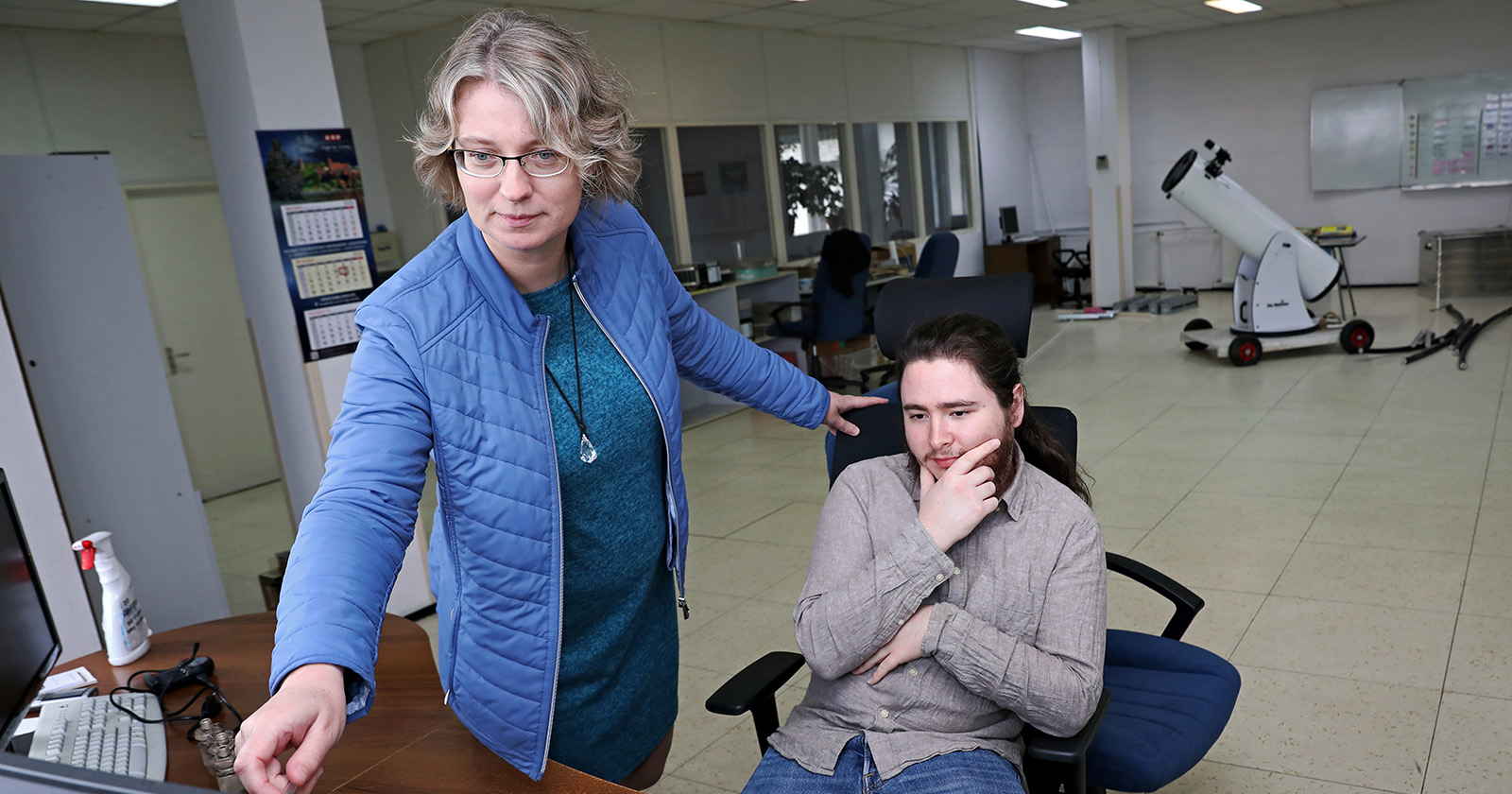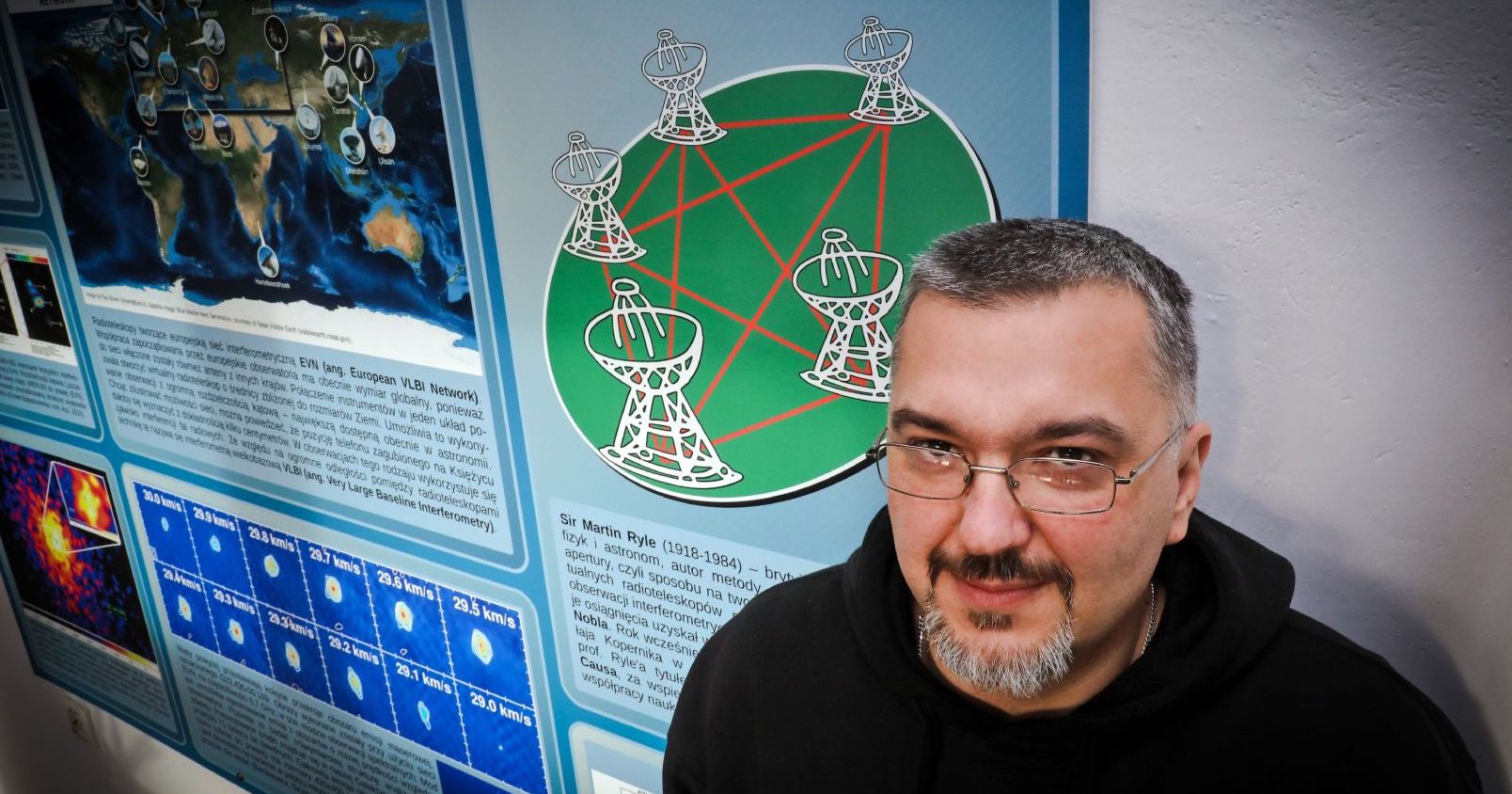 Exact sciences
Exact sciences
Protostar in spiral arms
An international team of astronomers, which includes three researchers affiliated with the Nicolaus Copernicus University, has succeeded in mapping the protostellar disk with the highest precision known today. The discovery provides evidence predicted by the theory of episodic accretion.
The work was recognized by the journal Nature Astronomy, where an article has just been published "A Keplerian disk with a four-arm spiral birthing an episodically accreting high-mass protostar". Among the authors - an international group of astronomers specializing in observations of maser emissions - were three researchers affiliated with the Institute of Astronomy at the NCU Faculty of Physics, Astronomy and Informatics: dr. habil. Anna Bartkiewicz, NCU Prof., mgr Michal Durjasz, and dr. Mateusz Olech, who defended his doctorate at the Faculty and is now part of the team of the Space Radio Diagnostics Centre at the University of Warmia and Mazury in Olsztyn).
Joint effort
In his scientific work, dr habil. Anna Bartkiewicz, NCU Prof. is concerned with the study of star-forming objects showing the ring structure of the methanol maser. With the help of the European VLBI Network, she precisely determines the natural motions of the maser clouds at the level of a few kilometres per second. She is currently leading the Opus grant of the National Science Centre "Space masers as a tool for identifying accretion explosions of massive protostars". Michal Durjasz, a PhD student at the Nicolaus Copernicus University Doctoral School of Exact and Natural Sciences, has also made a major contribution to the research, working on areas of massive stars with abrupt changes in methanol maser emission. Both researchers belong to the IDUB Centre of Excellence "Astronomy and Astrophysics" Mateusz Olech, on the other hand, is interested in star-forming regions and periodic changes of methanol masers around massive protostars.

Andrzej Romański
The article, and especially the research that preceded it, is the result of a successful collaboration between experts from around the world.
Observational data acquired from 24 radio telescopes from around the world contributed to our discovery, which was then carefully correlated by teams at three centres on three different continents, explains dr Ross Burns of the National Astronomical Observatory of Japan, first author of the paper. - Around 150 people were involved, and we would like to express our gratitude to them for their efforts, hoping for further collaboration in the future.
Mysteries of the stars
The researchers focused on observations of massive stars, i.e. those with masses greater than eight masses of the Sun. They play a key role in the production of the elements necessary to build life in the Universe and also influence the formation and evolution of galaxies. The most massive stars die and become enigmatic black holes.
Despite their importance in the Universe, the process of massive star formation has been shrouded in mystery for many decades.
So far, there has been no single theory accepted by the entire scientific community to explain their formation, explains Professor Anna Bartkiewicz. - It has only recently been confirmed that massive stars are born in the centres of rotating disks composed of gas and dust. Protostellar disks, as they are called, have a radius of about one thousand astronomical units, i.e., the average distance between the Earth and the Sun multiplied by one thousand [the astronomical unit, or conventional measure of distance used in astronomy, is the average distance between the Earth and the Sun; i.e., 149597870.7 km, or - editor's note].
One theory of massive star formation that is becoming increasingly popular among researchers is episodic accretion.
Accretion, or the deposition of matter on a star. It involves clouds of dusty gas occasionally 'breaking off' and dropping from the disk onto a growing protostar, i.e., a young star located in the centre, explains mgr Michał Durjasz, - During such surges in the rate of matter accretion, the star accumulates more than half of the mass it gains during the formation stage. These accretion rate surges, or episodic accretion, are very rare events: they occur every hundreds or thousands of years and last from a few months to a few years.
Until now, astronomers have only witnessed a few such phenomena. The most recent and most thoroughly studied was the rapid accretion of the massive protostar G358-MM1 (the name is related to the object's coordinates in the sky) in 2019.

Andrzej Romański
- The episodic accretion theory suggests that protostellar disks are massive and inhomogeneous. Due to the influence of their own gravity, spiral arms may appear in them, adds dr Mateusz Olech. - The very observation of protostellar disks in the areas of birth of massive stars is a challenge for astronomers - they are formed in dense molecular clouds that are impenetrable to conventional optical astronomy. Observing potential spiral arms is even more challenging.
Disk map
In the latest publication in Nature Astronomy, an international team of astronomers specialising in observations of maser emission - which is the naturally-occurring cosmic counterpart of a laser at microwave radio wavelengths - has been able to obtain maps of the protostellar disk with the highest precision known today. Using a network of radio telescopes, so-called very long baseline interferometry (VLBI), the scientists discovered spiral arms in the rotating disk of a high-mass protostar - G358-MM1. This is the same protostar that underwent rapid accretion in 2019.
The team used a new technique called 'heat-wave mapping', which produces a set of maps of the brightened masers of methanol molecules at different stages of an event. A total of 24 radio telescopes from Oceania, Asia, Europe and America were used. This allowed us to image the G358-MM1 spiral disk with a resolution of one angular millisecond, i.e., 1/3600000th of a degree, explains Prof Bartkiewicz. - G358-MM1 has four spiral arms that wrap around the protostar. These help to carry material from the disk to the centre of the system, where it can reach the protostar. If more spiral systems and this type of brightness are discovered, astronomers will be able to understand better the processes that accompany the birth of high-mass stars, which are the true cradle of life in the Universe.

Right: Map of the 6.7 GHz methanol maser emission in G358-MM1, imaged using heatwave mapping. The cross in the center represents the location of the high-mass protostar determined in millimetre wavelength interferometric imaging. Spiral structures can be seen, wrapping around the protostar in a clockwise direction. Colours show the velocity of gas. Regions in blue are moving toward us while red regions show gas that is moving away. Overall, the colours indicate that the system is rotating, in the form of a Keplerian disk, around G358-MM1
Credit: Charles Willmott and Ross Burns
The discovery provides observational evidence for several aspects predicted by episodic accretion theory: a rotating disk, rapid brightening and a spiral structure that helps 'feed' a growing high-mass protostar. The team will continue to search for such bursts of maser emission, using a global collaboration of traditional radio telescopes called the Maser Monitoring Organisation (M2O https://www.masermonitoring.com/). So far, only three rapid brightening high-mass protostars have been observed, but the researchers hope to find many more.
 NCU News
NCU News






 Exact sciences
Exact sciences
 Exact sciences
Exact sciences

 Exact sciences
Exact sciences